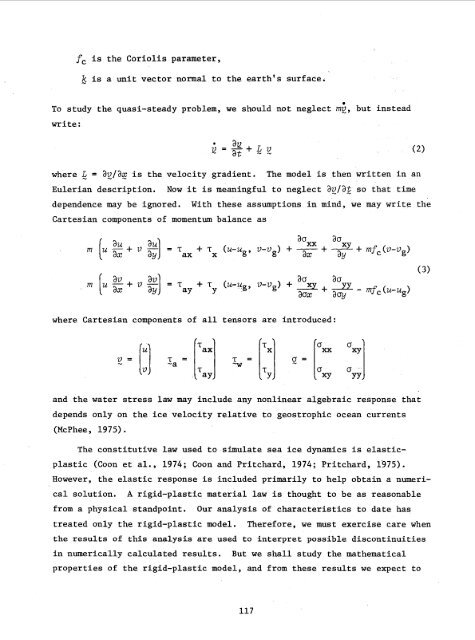AIDJEX Bulletin #40 - Polar Science Center - University of Washington
AIDJEX Bulletin #40 - Polar Science Center - University of Washington
AIDJEX Bulletin #40 - Polar Science Center - University of Washington
Create successful ePaper yourself
Turn your PDF publications into a flip-book with our unique Google optimized e-Paper software.
fc is the Coriolis parameter,<br />
- k is a unit vector normal to the earth's surface;<br />
To study the quasi-steady problem, we should not neglect mg, but instead<br />
write:<br />
where & = ag/ag is the velocity gradient. The model is then written in an<br />
Eulerian description.<br />
Now it is meaningful to neglect av_/at so that time<br />
dependence may be ignored. With these assumptions in mind, we may write the<br />
Cartesian components <strong>of</strong> momentum balance as<br />
where Cartesian components <strong>of</strong> all tensors are introduced:<br />
and the water stress law may include any nonlinear algebraic response that<br />
depends only on the ice velocity relative to geostrophic ocean currents<br />
(McPhee, 1975).<br />
The constitutive law used to simulate sea ice dynamics is elasticplastic<br />
(Coon et al., 1974; Coon and Pritchard, 1974; Pritchard, 1975).<br />
However, the elastic response is included primarily to help obtain a numerical<br />
solution. A rigid-plastic material law is thought to be as reasonable<br />
from a physical standpoint. Our analysis <strong>of</strong> characteristics to date has<br />
treated only the rigid-plastic model. Therefore, we must exercise care when<br />
the results <strong>of</strong> this analysis are used to interpret possible discontinuities<br />
in numerically calculated results. But we shall study the mathematical<br />
properties <strong>of</strong> the rigid-plastic model, and from these results we expect to<br />
117








